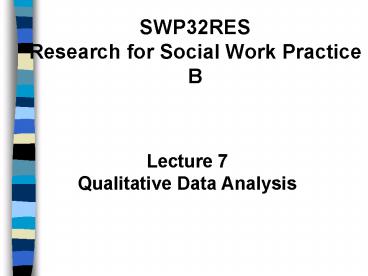Qualitative Data Analysis - PowerPoint PPT Presentation
1 / 20
Title:
Qualitative Data Analysis
Description:
'The interpretive act remains mysterious in qualitative and quantitative data analysis. It is a process of bringing meaning to raw, inexpressive data that is necessary ... – PowerPoint PPT presentation
Number of Views:266
Avg rating:3.0/5.0
Title: Qualitative Data Analysis
1
SWP32RES Research for Social Work Practice B
Lecture 7 Qualitative Data Analysis
2
- The interpretive act remains mysterious in
qualitative and quantitative data analysis. It
is a process of bringing meaning to raw,
inexpressive data that is necessary whether the
researchers language is ANOVAs and means or rich
descriptions of ordinary events (Marshall and
Rossman 1989, p.114)
3
Major differences between the quantitative data
analysis and qualitative data analysis
- 1) Quantitative analysis uses numbers as the
unit of analysis whereas qualitative analysis
uses words (derived from observations and
interviews and then recorded in this form)
4
2) With quantitative data, analysis may well be
(and should be) worked out in the planning
stages eg. what statistical tests are going to
be used whereas with qualitative data it
simply cannot be decided upon in the planning
stages.
5
3) With quantitative data, analysis takes place
at the conclusion of data collection but in
qualitative data research it may take place
over the course of the research process,
especially during data collection.
6
PRINCIPLES OF PATTERN RECOGNITION (KELLEHEAR,
1993)
- 1) CONTENT ANALYSIS
- 2) THEMATIC ANALYSIS
- 3) SEMIOTIC ANALYSIS
7
PRACTICAL PRINCIPLES IN CONTENT ANALYSIS
(KELLEHEAR, 1993)
- 1) DECIDE ON CERTAIN CATEGORIES
- 2) CHOOSE THE SAMPLE
- 3) SELECT THE TIME PERIOD FOR SAMPLING
8
- 4) DECIDE ON THE NUMBER OF EVENTS TO BE
OBSERVED, ISSUES TO BE READ ETC. - 5) RECORD THE OBSERVATIONS
SYSTEMATICALLY
9
MEASURES IN CONTENT ANALYSIS (KELLEHEAR, 1993)
- SIZE OF TIME/SPACE ALLOCATIONS
- SIMPLE APPEARANCE
- FREQUENCIES
- INTENSITY
10
CATEGORIES USED IN CONTENT ANALYSIS (KELLEHEAR,
1993)
- COMPREHENSIVE
- SPECIFIC CLEAR
- SUPPORTED BY PRECISE DEFINITIONS
11
BASIC PRINCIPLES IN THEMATIC ANALYSIS (MILES
HUBERMAN, 1984)
- 1) COUNT (LOOK FOR REPETITION)
- 2) NOTE THEMES, PATTERNS
- 3) MAKE METAPHORS, ANALOGIES OR SYMBOLS OF
WHAT IS HAPPENING
12
- 4) CHECK TO SEE IF SINGLE OCCURRENCES ARE
REALLY SEVERAL - 5) CONNECT PARTICULAR EVENTS TO GENERAL ONES
- 6) NOTE DIFFERENCES SIMILARITIES
13
- 7) NOTE TRIGGERING, CONNECTING OR
MEDIATING VARIABLES - 8) NOTE IF PATTERNS IN THE DATA RESEMBLE
CONCEPTS /OR THEORIES
14
PRACTICAL PRINCIPLES OF SEMIOTIC ANALYSIS
(KELLEHEAR, 1993)
- 1) ASSEMBLE ALL AVAILABLE MATERIAL TOGETHER,
SUPPLYING AS MUCH INFORMATION ABOUT
CONTEXT AS POSSIBLE - 2) IDENTIFY THE OPPOSITIONAL ELEMENTS
15
- 3) COMPARE THE DIFFERENT ACCOUNTS/ELEMENTS
- 4) TRACE THEIR SOURCE BEYOND THE SETTING
16
- 5) CRITICALLY APPLY THEORETICAL TRADITIONS
WHICH ARE SENSITIVE AND COGNISANT OF SOCIAL
PROCESSES WHICH REPRESS, DISTORT,
MYSTIFY OR OVERSIMPLIFY SOCIAL
RELATIONS
17
PROCESS OF DISCOURSE ANALYSIS (POTTER
WEATHERALL, 1994)
- 1) IDENTIFY VARIETY WITHIN THE INFORMATION
- 2) IDENTIFY PAUSES, HESITATIONS OR
NON-VERBALS - 3) SEEK DIFFERENT LEVELS OF MEANINGS
ALTERNATIVE VIEWS
18
- 4) QUESTIONS WHICH VALUES OR IDEOLOGIES ARE
BEING DRAWN UPON - 5) QUESTION WHICH POWER RELATIONS HAVE SHAPED
THE DISCOURSES TRACE THEM HISTORICALLY
19
- 6) SEEK EVIDENCE OF CHALLENGE OR
RESISTANCE TO IDENTIFIABLE DISCOURSES - 7) WHAT ARE THE RESULTS OF THESE CHALLENGES?
20
Coding
- The process of identifying persistent words,
phrases, themes or concepts within the data, so
that underlying patterns can be identified and
analysed































